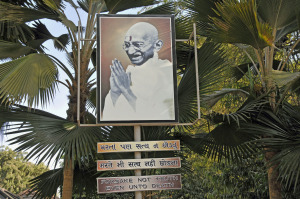In 1915, after working 21 years in South Africa as a lawyer, Mohandas Gandhi came to Ahmedabad to employ his ideas of non-violent resistance in support of Indian independence. In 1917, he acquired 36 acres of wasteland along the west bank of the Sabarmati River and built an “ashram” on the previously snake-infested site. He and his followers lived together at the ashram seeking truth while practicing Gandhi’s ideals of discipline, chastity, religious tolerance, self-reliance and non-violence. One of Gandhi’s objectives was demonstrating that Indian people did not need to rely on the British, so he and his followers made their own cloth and grew their own food. In 1930, while living at the ashram, Gandhi organized a 241-mile march to the sea protesting the British salt tax. The event eventually led to the arrest of 60,000 people and galvanized the Indian public in support of independence. After the march, the British government seized Gandhi’s ashram.
India received its independence in August 1947. Five months later, before Gandhi could return to the ashram, he was assassinated by a Hindu nationalist who thought his teachings were too tolerant of Muslims. The government now maintains the tranquil, tree-filled grounds of the “Sabarmati Ashram” as a shrine to the person Indians now call “Mahatma,” the Great Soul. Some of Gandhi’s simple personal possessions are exhibited in the small house where he lived for 12 years with his wife Kasturba. A museum houses his letters, writings and pictures and displays some of his most famous teachings, including, “If blood be shed, let it be our own” and “Forsake not truth, even unto death.” The museum also displays the folding spinning wheel that Gandhi encouraged Indians to use to reduce their dependence on British imports.
The Sabarmati Ashram is Ahmedabad’s most popular destination. For admirers of Gandhi’s philosophy of tolerance and non-violence, it should be part of any trip to India.

Comments are closed.